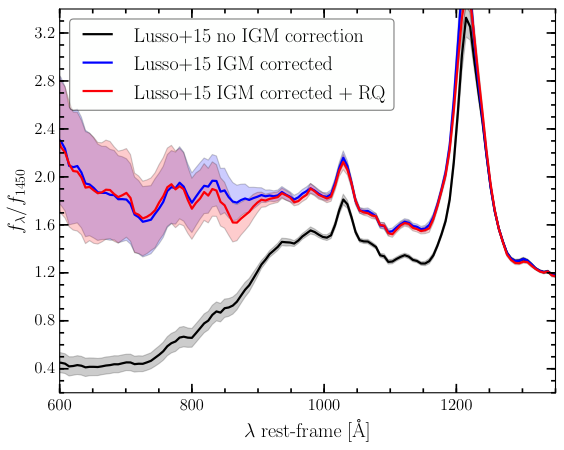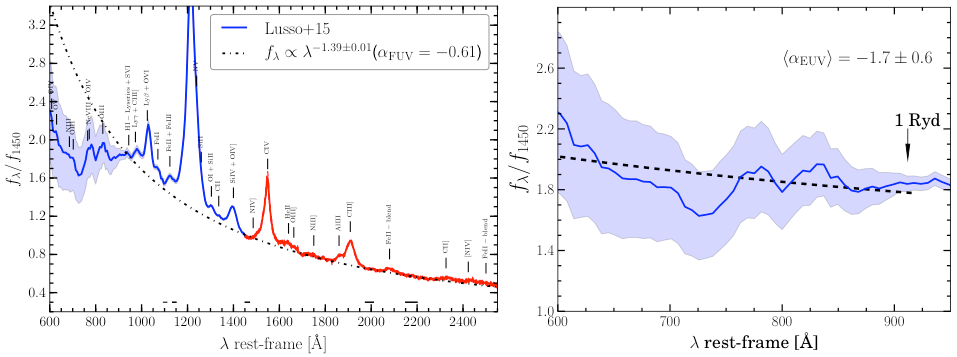The first ultraviolet average spectrum of z=2.4 quasars
The central regions of a sizable fraction of galaxies harbor high-energy sources whose broad emission across the electromagnetic spectrum cannot be explained through a synthesis of stellar populations. These objects are known as Active Galactic Nuclei (AGN) or quasi-stellar objects (quasars/QSOs). Quasars are the most luminous AGN and completely outshine their host galaxies. The ionizing continuum from AGN is fundamental for interpreting their broad emission lines and understanding their impact on the surrounding gas. Furthermore, it provides hints on how matter accretes onto supermassive black holes, the mechanism at the origin of the AGN emission. A proper determination of the spectral energy distribution (SED) is therefore fundamental in order to assess several physical parameters of Quasars (first of all, their total intrinsic luminosity).
The AGN continuum emission shows a prominent bump, the so-called ``Big Blue Bump" (BBB), which appears to peak in the optical-ultraviolet (UV) and declines at shorter wavelengths. The UV deficit between ~300 and 912 Å is due to absorption by neutral hydrogen in the intergalactic medium (IGM) intervening between the Quasar and the observer, which makes the detection at these wavelengths extremely difficult. Most of the QSO emission (>70%) is nonetheless in the optical-UV and considerable effort has been devoted to characterize the shape of the quasar ionizing continuum in the UV over the past years. However, the majority of previous studies have focused their attention on quasar samples at relatively low redshifts (z<2), with very few objects at redshifts ~2-3, given that the IGM absorption is higher as the distance of the quasar from the Earth increases.
A team of astronomers led by Elisabeta Lusso (INAF-Arcetri Observatory) has recently published the first average spectrum of high-redshift quasars in the rest-frame wavelength range 600-2500 Å corrected for intervening HI Lyman forest and continuum absorption with state-of the-art IGM transmission functions calibrated to the most recent observations. They analyzed a sample consisting on 53 QSOs at z~2.4 selected from the HST survey for Lyman limit absorption systems (LLSs) using the Wide Field Camera 3 (WFC3).
The resulting average spectrum prior IGM absorption correction is shown in Figure 1 with the black solid line. The steep decline in the flux below 1216 Å (the rest-frame wavelength of Lyα emission in the quasar spectrum) is due to absorption from the IGM, which attenuates the quasar flux, both in the Lyman series (creating the so-called HI forest), and in the Lyman continuum at rest λ<912 Å.
 |
Figure 1: Mean QSO spectrum with uncertainties (shaded area) before correcting for IGM absorption (black) and after (blue for all QSOs in the HST/WFC3 sample and in red only for radio-quiet quasars). |
The average spectrum after IGM absorption correction is shown in Figure 1 (blue for the whole sample; red for only radio-quiet QSOs). The IGM corrected spectra show a flattening at wavelengths λ<912 Å and several emission lines (see Fig.2). The continuum fit of the spectrum presented in Fig.2 shows clearly that a single power-law provides an excellent fit up to ~900 Å where the continuum exhibits a break. A flatter (softer) spectrum is present at shorter wavelength, which is not modelled by the simple single power-law. This result emphasizes that a single (or any broken) power law fails to describe the entire quasar SED and it does not have any physical grounds.
 |
|
Figure 2: Left panel: Average spectrum (combining WFC3 and SDSS data) normalized at 1450 Å with fits to power-law continuum (dot-dashed line). Five continuum windows are shown as black horizontal lines below the spectrum. It is apparent that a single power-law provides an excellent fit up to ~900 Å where the continuum exhibits a break. A flatter (softer) spectrum is present at shorter wavelength, which is not modelled by the simple single power-law. Right panel: Zoom in of the Extreme UV region (600-912 Å). The dashed line is the power-law continuum by employing the average EUV spectral slope. |
Additionally, this UV average spectrum offers the possibility to investigate the QSO properties in the context of photoionization, accretion disk models, and quasar contribution to the ultraviolet cosmic background in a redshift range previously unexplored. This study found that the observed broad line ratios are consistent with those predicted assuming an ionizing slope similar to the observed ionizing spectrum in the same wavelength range. The continuum break and softening are consistent with accretion disk plus X-ray corona models when black hole spin is taken into account. In particular, non zero values of the black hole spin are needed to match the data, with higher values of the black hole spin as the black hole mass increases. Finally, this spectral energy distribution yields a 30% increase to previous estimates of the specific quasar emissivity, such that quasars may contribute significantly to the total specific Lyman limit emissivity estimated from the Lyα forest at z< 3.2.
The results of this work are presented in “The first ultraviolet quasar stacked spectrum at z=2.4 from WFC3”, Lusso et al., MNRAS in press.
Edited by Anna Gallazzi and Elisabeta Lusso, 9/4/2015



